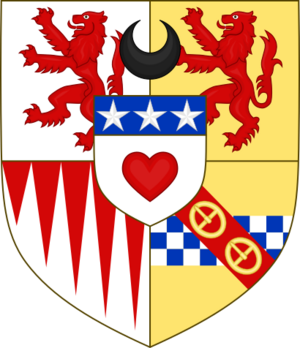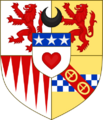George Douglas of Pittendreich facts for kids
George Douglas of Pittendreich (who died in 1552) was an important member of the powerful Red Douglas family in Scotland. This family tried to control the young James V of Scotland in 1528. George Douglas's second son, James Douglas, 4th Earl of Morton, later became a very important leader called the Regent of Scotland. At first, George Douglas supported the idea of Mary, Queen of Scots marrying Prince Edward of England. But after war started between England and Scotland, he worked for peace and helped increase the power of Mary of Guise, who was James V's widow and Mary, Queen of Scots's mother.
Contents
Who Was George Douglas?
George Douglas was the brother of Archibald Douglas, 6th Earl of Angus. Because of this, people often called him "Master of Angus." His parents were also named George Douglas (Master of Angus) and Elizabeth Drummond. George married Elizabeth Douglas, who was the daughter and heir of David Douglas of Pittendreich, a place near Elgin.
The Douglas Family's Power
The Douglas family became very powerful and took charge of the young King James V in 1526. However, the King managed to escape from them in 1528. After his escape, King James V attacked Tantallon Castle, which belonged to the Douglases, in 1529. The Scottish Parliament then took away the lands and titles of many Douglas family members and their friends.
When the family got their lands and titles back in 1543, George Douglas helped the Earl of Morton get his lands back. To make their family ties stronger, George arranged for his son, James (who would later become the Regent), to marry the Earl of Morton's youngest daughter, Elizabeth Douglas.
George also had an older son, David Douglas, who became the 7th Earl of Angus. David married Margaret Hamilton.
George Douglas and the Young King
In 1515, George Douglas tried to protect Stirling Castle for Margaret Tudor, who was the King's mother. He wanted to stop Regent Albany from taking control of James V, but he eventually had to leave the castle.
Later, in 1517, George was put in prison in places like Edinburgh Castle and Blackness Castle. This happened because people were worried the Douglas family might try to kidnap the King.
Protecting the King (and Controlling Him)
In August 1526, the Earl of Lennox tried to take King James V from Holyroodhouse Palace. The Douglases moved the King to a safer house in Edinburgh. There, George Douglas watched over him with 40 men.
When the Earl of Lennox and George's brother, Angus, fought near Linlithgow in September 1526, George Douglas was sent to bring more soldiers and the young King. The King tried to slow George down. Near Edinburgh, George even raised his voice to James V and threatened him.
The King Escapes
In May 1528, King James V finally escaped from the Douglases and from George's care. He rode to his mother at Stirling Castle. Stories say that James escaped from Falkland Palace at night. When George Douglas found out the King was gone, he and his brother Archibald rode to Stirling. But they learned that King James had declared that the Douglases were not allowed within six miles of him.
After this, the Scottish Parliament took away the Douglas family's lands and titles. Even though King James's attack on their Tantallon Castle was not successful, the Douglases had to go into exile in England.
Working for Peace and Marriage Plans
After King James V died, George Douglas and his brother returned to Scotland in January 1543. They had been in England. George was welcomed back and met with important Scottish leaders.
Planning the English Marriage
At first, George Douglas supported the idea of Mary, Queen of Scots marrying Prince Edward of England. He even went to London in April 1543 to represent the Scottish Parliament.
Mary of Guise, who was Mary, Queen of Scots's mother, was another powerful person in Scotland. She told an English diplomat that George Douglas was "as wily and crafty a man as any was in all Scotland." This meant he was very clever and tricky.
George Douglas and another Scottish leader, the Earl of Glencairn, went to meet King Henry VIII of England in May 1543. George stayed for only a few days. He carried proposals back to Scotland, which suggested that Mary would be sent to England when she was 8 or 10 years old and marry Edward when she was twelve.
The Treaty of Greenwich
On July 1, George was back in London to help finish the Treaty of Greenwich. This treaty was meant to bring peace between England and Scotland and make the royal marriage plan happen.
George then tried to get the Scottish leader, Regent Arran, and Cardinal Beaton to agree. Cardinal Beaton was against the marriage. George worked hard to make peace, but despite his efforts, Regent Arran and the Scottish Parliament rejected the Treaty of Greenwich in December 1543. This led to a war known as the Rough Wooing.
The Rough Wooing War
After English attacks in 1544, some people wanted to remove Arran as regent and give the role to Mary of Guise. George and his brother, the Earl of Angus, supported Mary of Guise and were put in Blackness Castle for a short time.
In June, George sent a messenger to Mary of Guise and advised her to tell the King of France to deal only with her, not with Regent Arran. In September, Mary of Guise gave George a regular payment, and he wrote to her, promising his loyalty.
In February 1545, George wrote a letter to King Henry VIII of England. He explained that the war was making Henry lose support in Scotland. George offered advice, saying that the Scottish people were afraid because of the harsh war, where women and children were being killed. He suggested that gentle handling and kind words would win over the people's favor, which would help Henry's plans.
Before the Battle of Pinkie
A month before the battle of Pinkie in 1547, an English leader offered to negotiate with George Douglas to avoid invading Scotland. However, Regent Arran did not agree to this meeting. So, no meeting happened, and the Scottish army was defeated by the English at Pinkie Cleugh in September 1547.
Fighting at Dalkeith
In 1548, George Douglas was in touch with an English commander and became the captain of Yester Castle and Dalkeith. However, the English realized that George was now supporting the Scottish Regent. So, they tried to trap George at Dalkeith Palace. Dalkeith was captured in June 1548 after a battle. George escaped, but his son James was captured and hurt. George's wife, Elizabeth Douglas, was also captured. The English released her after she promised to try and get her husband to support the English again.
Working for Mary of Guise
In July 1548, one of George's servants was given money to gather information in England. In September 1549, an English soldier hoped to capture George Douglas to help release some Scottish prisoners held in France.
George Douglas died in 1552 in northern Scotland. He was serving Mary of Guise at the time of his death.
Images for kids



